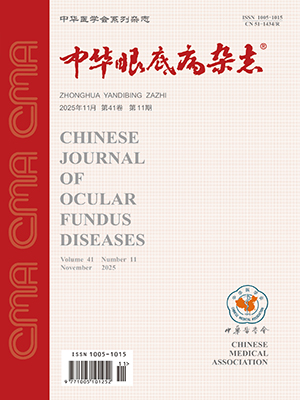| 1. |
国家重点研发计划2020YFC2008200项目组, 中华医学会眼科学分会眼视光学组, 中国医师协会眼科医师分会眼视光专业委员会. 中国低视力康复临床指南(2021)[J]. 中华眼视光学与视觉科学杂志, 2021, 23(3): 161-170. DOI: 10.3760/cma.j.cn115909-20210221-00068.Research Panel of the National Key R&D Project 2020YFC2008200, Chinese Optometric Association of Chinese Ophthalmological Society, Optometry Committee of Chinese Ophthalmologists. Chinese Low Vision Rehabilitation Clinical Guideline (2021)[J]. Chin J Optom Ophthalmol Vis Sci, 2021, 23(3): 161-170. DOI: 10.3760/cma.j.cn115909-20210221-00068.
|
| 2. |
陈建华, 徐亮, 胡爱莲, 等. 北京市城乡限定人群低视力与盲的患病率及其病因的调查[J]. 中华医学杂志, 2003, 83(16): 1413-1418. DOI: 10.3760/j:issn:0376-2491.2003.16.012.Chen JH, Xu L, Hu AL, et al. Prevalence of low vision and blindness in defined populations in rural and urban areas in Beijing[J]. Natl Med J China, 2003, 83(16): 1413-1418. DOI: 10.3760/j:issn:0376-2491.2003.16.012.
|
| 3. |
邹海东, 张皙, 许迅, 等. 上海市北新泾街道老年人低视力和盲的流行病学调查[J]. 中华眼科杂志, 2002, 38(12): 744-746. DOI: 10.3760/j:issn:0412-4081.2002.12.011.Zou HD, Zhang X, Xu X, et al. An epidemiological survey of low vision and blindness of senile persons in Beixinjing blocks, Shanghai[J]. Chin J Ophthalmol, 2002, 38(12): 744-746. DOI: 10.3760/j:issn:0412-4081.2002.12.011.
|
| 4. |
Fletcher DC, Schuchard RA. Preferred retinal loci relationship to macular scotomas in a low-vision population[J]. Ophthalmology, 1997, 104(4): 632-638. DOI: 10.1016/s0161-6420(97)30260-7.
|
| 5. |
Crossland MD, Culham LE, Kabanarou SA, et al. Preferred retinal locus development in patients with macular disease[J]. Ophthalmology, 2005, 112(9): 1579-1585. DOI: 10.1016/j.ophtha.2005.03.027.
|
| 6. |
Whittaker SG, Budd J, Cummings RW. Eccentric fixation with macular scotoma[J]. Invest Ophthalmol Vis Sci, 1988, 29(2): 268-278.
|
| 7. |
Tarita-Nistor L, González EG, Markowitz SN, et al. Plasticity of fixation in patients with central vision loss[J]. Vis Neurosci, 2009, 26(5-6): 487-494. DOI: 10.1017/S0952523809990265.
|
| 8. |
Holocomb JG, Goodrich GL. Eccentric viewing training[J]. J Am Optom Assoc, 1976, 47(11): 1438-1443.
|
| 9. |
Goodrich GL, Quillman RD. Eccentric viewing training[J]. JVIB, 1977, 71(9): 377-381. DOI: 10.1177/0145482X7707100.
|
| 10. |
Inde K. Low vision training in Sweden[J]. JVIB, 1978, 72(8): 307-310. DOI: 10.1177/0145482X7807200803.
|
| 11. |
Peli E. Control of eye movement with peripheral vision: implications for training of eccentric viewing[J]. Am J Optom Physiol Opt, 1986, 63(2): 113-118. DOI: 10.1097/00006324-198602000-00006.
|
| 12. |
Maplesden C. A subjective approach to eccentric viewing training[J]. JVIB, 1984, 78(1): 5-6. DOI: 10.1177/0145482X8407800102.
|
| 13. |
Sabel BA, Henrich-Noack P, Fedorov A, et al. Vision restoration after brain and retina damage: the "residual vision activation theory"[J]. Prog Brain Res, 2011, 192: 199-262. DOI: 10.1016/B978-0-444-53355-5.00013-0.
|
| 14. |
Kasten E, Wüst S, Behrens-Baumann W, et al. Computer-based training for the treatment of partial blindness[J]. Nat Med, 1998, 4(9): 1083-1087. DOI: 10.1038/2079.
|
| 15. |
Chung STL. The Glenn A. Fry Award Lecture 2012: plasticity of the visual system following central vision loss[J]. Optom Vis Sci, 2013, 90(6): 520-529. DOI: 10.1097/OPX.0b013e318294c2da.
|
| 16. |
Liu T, Cheung SH, Schuchard RA, et al. Incomplete cortical reorganization in macular degeneration[J]. Invest Ophthalmol Vis Sci, 2010, 51(12): 6826-6834. DOI: 10.1167/iovs.09-4926.
|
| 17. |
Dilks DD, Baker CI, Peli E, et al. Reorganization of visual processing in macular degeneration is not specific to the “preferred retinal locus”[J]. J Neurosci, 2009, 29(9): 2768-2773. DOI: 10.1523/JNEUROSCI.5258-08.2009.
|
| 18. |
中华人民共和国民政部. 低视力康复[S]. 2020-10-23.Ministry of Civil Affairs of the People's Republic of China. Low vision rehabilitation. 2020-10-23.
|
| 19. |
Fontenot JL, Bona MD, Kaleem MA, et al. Vision rehabilitation preferred practice patternp[J]. Ophthalmology, 2018, 125(1): 228-278. DOI: 10.1016/j.ophtha.2017.09.030.
|
| 20. |
俞素勤, 王卫峻, 邹海东, 等. 黄斑区脉络膜新生血管患者的微视野检查[J]. 中华眼底病杂志, 2004, 20(2): 116-117. DOI: 10.3760/j.issn:1005-1015.2004.02.016.Yu SQ, Wang WJ, Zou HD, et al. Microscopical examination of choroidal neovascularization in macular area[J]. Chin J Ocul Fundus Dis, 2004, 20(2): 116-117. DOI: 10.3760/j.issn:1005-1015.2004.02.016.
|
| 21. |
俞素勤, 王卫峻, 许迅. 湿性年龄相关性黄斑变性患者的视功能研究[J]. 上海交通大学学报(医学版), 2008, 28(6): 688-690.Yu SQ, Wang WJ, Xu X, et al. Visual function in patients with wet age-related macular degeneration[J]. Journal of Shanghai Jiaotong University(Medical Science), 2008, 28(6): 688-690.
|
| 22. |
徐吉, 魏璐, 俞素勤, 等. 病理性近视患者黄斑功能的微视野检查[J]. 中华眼底病杂志, 2011, 27(1): 52-55. DOI: 10.3760/cma.j.issn.1005-1015.2011.01.012.Xu J, Wei L, Yu SQ, et al. Macular function of pathologic myopic retina evaluated by microperimetry[J]. Chin J Ocul Fundus Dis, 2011, 27(1): 52-55. DOI: 10.3760/cma.j.issn.1005-1015.2011.01.012.
|
| 23. |
梁冬青, 刘玉燕, 韩泉洪. 微视野生物反馈训练及其在黄斑疾病中的应用研究现状及进展[J]. 中华眼底病杂志, 2020, 36(10): 817-820. DOI: 10.3760/cma.j.cn511434-20190521-00180.Liang DQ, Liu YY, Han QH, et al. Current situation and progress of microperimeter biofeedback training and its application in macular diseases[J]. Chin J Ocul Fundus Dis, 2020, 36(10): 817-820. DOI: 10.3760/cma.j.cn511434-20190521-00180.
|
| 24. |
邹海东, 张晳, 许迅, 等. 低视力者生活质量量表中文版的研制和信度与效度考评[J]. 中华眼科杂志, 2005, 41(3): 246-251. DOI: 10.3760/j:issn:0412-4081.2005.03.013.Zou HD, Zhang X, Xu X, et al. Development and evaluation of psychometric tests of the Chinese-version of low vision quality of life questionnaire[J]. Chin J Ophthalmol, 2005, 41(3): 246-251. DOI: 10.3760/j:issn:0412-4081.2005.03.013.
|
| 25. |
Mangione CM, Lee PP, Gutierrez PR, et al. Development of the 25-item National Eye Institute Visual Function Questionnaire[J]. Arch Ophthalmol, 2001, 119(7): 1050-1058. DOI: 10.1001/archopht.119.7.1050.
|
| 26. |
Wolffsohn JS, Cochrane AL. Design of the low vision quality-of-life questionnaire (LVQOL) and measuring the outcome of low-vision rehabilitation[J]. Am J Ophthalmol, 2000, 130(6): 793-802. DOI: 10.1016/s0002-9394(00)00610-3.
|
| 27. |
薛文文, 邹海东. 中文版低视力者生活质量量表的rasch模型分析及优化[J]. 中华眼科杂志, 2019, 55(8): 582-588. DOI: 10.3760/cma.j.issn.0412-4081.2019.08.007.Xue WW, Zou HD. Rasch analysis of the Chinese Version of the Low Vision Quality of Life Questionnaire[J]. Chin J Ophthalmol, 2019, 55(8): 582-588. DOI: 10.3760/cma.j.issn.0412-4081.2019.08.007.
|
| 28. |
Schumacher EH, Jacko JA, Primo SA, et al. Reorganization of visual processing is related to eccentric viewing in patients with macular degeneration[J]. Restor Neurol Neurosci, 2008, 26((4-5): 391-402.
|
| 29. |
Dilks DD, Julian JB, Peli E, et al. Reorganization of visual processing in age-related macular degeneration depends on foveal loss[J]. Optom Vis Sci, 2014, 91(8): 199-206. DOI: 10.1097/OPX.0000000000000325.
|
| 30. |
刘文织. 低视力患者心理健康状况与社会支持相关性研究. 中医临床研究, 2016, 8(16): 108-109. DOI: 10.3969/j.issn.1674-7860.2016.16.057.Liu WZ. A study on the relationship between mental health status and social support in patients with low vision[J]. Clinical Journal of Chinese Medicine, 2016, 8(16): 108-109. DOI: 10.3969/j.issn.1674-7860.2016.16.057.
|
| 31. |
张海平, 谭伙连, 吴伟霞, 等. 护理干预对低视力患者心理健康状况的影响[J]. 齐鲁护理杂志, 2014, 20(19): 50-51. DOI: 10.3969/j.issn.1006-7256.2014.19.023.Zhang HP, Tan HL, Wu WX, et al. Effect of nursing intervention on mental health status of patients with low vision. Journal of Qilu Nursing, 2014, 20(19): 50-51. DOI: 10.3969/j.issn.1006-7256.2014.19.023.
|




